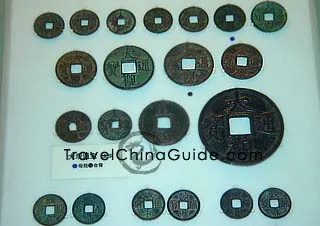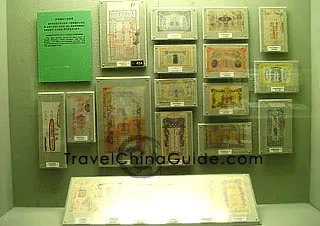Song Coins
The highlight of the monetary culture in the
Song Dynasty (960 - 1279) was that the characters on the coins were written by emperors. The initiator of this fashion was Emperor Tai Zong. He excelled in many fields and had a preference for calligraphy. His writing of Chun Hua Yuan Bao was bold and unrestrained, admired by later calligraphers.
 |
| Song Dynasty coins |
After Tai Zong, many emperors of the Song Dynasty wrote for the coins while the ones written by Emperor Hui Zong represented the zenith of the Song monetary culture.
The Chinese proverb goes, "Man should avoid entering a wrong industry while woman should avoid marrying a wrong husband." But what if you inherit the throne as an emperor? Do you have any choice? Emperor Hui Zong of the Northern Song Dynasty was such a tragic character. As a ruler, Hui Zong was unqualified. Politics was not where his interest lay and he appointed crafty ministers to reign over the country. He himself led an extremely luxurious life, extorting money from the people.
However, he was versatile in art and contributed to embroidery, painting, calligraphy and ci poem. He created a font of his own, shou jin, which features slim but firm with elegant demeanor. The four characters Da Guan Tong Bao written by Emperor Hui Zong reflect his calligraphy features to the full. It is generally regarded that to write on a coin is the most difficult for calligraphers, even much more difficult than seal cutting and plaque writing. In addition, these four characters were not easy to configure but Hui Zong achieved harmony and aesthetic feeling by outstanding skill.
Dui Qian (Couple Coins)
The Song Dynasty witnessed the achievement in artistic field; ci poem, paintings, and calligraphy all came to their pomp at this time. It was under such background that dui qian, originated from the Five Dynasties and the Ten States, gained its popularity. Literally, dui qian means couple coins. Two coins of the same bronze purity, weight, size, outline, and other specifications have the same characters written in different fonts. For example, one coin may have cursive script while another seal or regular script. From 1023 to 1180, a total of 30 pairs of couple coins were minted. Emperors, great litterateur Su Dong Po and brilliant historian Sima Guang all left their calligraphy on couple coins, adding more beauty and value to it. Dui qian is unique phenomena in Chinese monetary history, full reflecting Chinese people's love for symmetry.
Fei Qian (Remittance)
Fei qian developed rapidly in the Northern Song Dynasty. A new service of money remittance was launched by the government in 971. Some data show that from 995 to 997, the amount of remittance reached 1,780,000 guan. One guan was equal to 1,000 cash.
Jiao Zi - the Earliest Paper Currency in the World
 |
| Old Paper Notes |
Jiao zi is the earliest paper note in the world. It was first issued freely among the people and replaced the circulation of coins. Later 16 rich businessmen took it over. When they declined, jiao zi could not be cashed in and social turmoil exploded. In 1023 the Song government set up an office in
Chengdu to handle with the issuance of jiao zi. In the next year, stately jiao zi was issued.
The face value was first written at the time of issuance and later was printed. Two official seals were stamped to prevent counterfeit and private issuance was forbidden. One term of an issuance lasted two years and new jiao zi would be issued at the end of each term. Later, the period for one issuance was extended to two terms and the amount of the issuance doubled, which led to depreciation.
However, jiao zi occupies an important role in both the monetary development and the money printing history.
- Last updated on Aug. 07, 2025 by Gabby Li -

